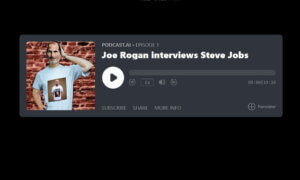Let’s talk about text-to-speech technology and its benefits for your business or personal use. Of course, some are better than others but most of them integrate the same system at the core which is based on the concept of speech synthesis.
What is Speech Synthesis?
According to Technopedia, Speech synthesis is an artificial simulation of human speech with a computer or other device. The counterpart of voice recognition, speech synthesis is mostly used for translating text information into audio information and in applications such as voice-enabled services and mobile applications. Speech Synthesis is also used to assist the vision-impaired when the display screen can be automatically read aloud. Synthesized speech is usually generated with the help of connecting parts of recorded speech, which is contained in a database, and the quality of the speech computer is often judged by its similarity to the human voice.
The counterpart speech of voice recognition – speech synthesis started pretty early, in 1779 with a device created by Professor Christian Kratzenstein to demonstrate the physiological contrasts involved in the production of extended vowel sounds.
The first fully functional device for voice recognition was shown at the 1939 World’s Fair. The so-called VODER (Voice Operating Demonstrator) was founded on Bell Laboratories’ vocoder research.
However, most computer operating systems have incorporated speech synthesizers since the early 1990s.
How does it work?
The process of speech synthesis starts with pre-processing, eliminating the vagueness on how certain word needs to be read, then the computer adopts phonemes to transform the text into a sequence of sound. Then, the computer uses human recordings or basic sound generation techniques to imitate the human voice and read out the text.
The majority of speech synthesis systems allow users to choose the type of voice such as male or female voice.
What are the benefits of using text-to-speech systems?
Creating speech content is quite expensive and takes a lot of time, and text-to-speech software can help with that. eLearning is a great example of using this software to make written content accessible through voice.
Let’s say you need to do a podcast, and you can’t afford the necessary equipment. In this case, all you need to do is work on the script, and let TTS software convert it to voice. TTS can be accessible and affordable and can help make knowledge and data accessible for many more people worldwide.
If we’re talking business, TTS software is the way to go if you need to extend the reach of your content and gain new customers, who sometimes are too busy to read your content. It also comes in handy with publishing, when you need to convert articles, stories, or books into audio.
Another important aspect for business, especially for content creators, is that TTS offers increased web presence, as websites with TTS technology attract some of the 774 million people worldwide with literacy issues and the 285 million people with visual impairments.
According to rSpeak.com, TTS is very important for the future of Business, as users can consume digital content across multiple devices with a signature omnichannel TTS voice: “The IoT is becoming a critical factor in digital business transformation. Companies across all verticals have digital marketing strategies in place and focus on engaging customers across various connected channels to optimize how they interact with them.”
As we’ve learned, users are more likely to return to a website where they had a good experience, and word of mouth is still the most important platform, according to Forbes. Therefore, having an alternative way to consume content online enhances the user experience.
What are the best text-to-speech apps out there?
Murf helps you add high-quality natural-sounding AI voices for your projects while providing a complete toolkit for making voice-over videos. You can combine images, videos, music, adjust timing, and so on. The app helps you create high-quality voiceovers using AI-powered voices and if you want to upload your recorded voiceover, you can always upload using the custom soundtrack feature. You can add voices to videos or images, get a free grammar assistant and add free background music to any video/audio.
Check out the feature section on the home page for more details on features.
Resemble AI is a great tool for game developers, entrepreneurs, and podcasters that uses to clone and create realistic voices in no time, from voices for games or a smart assistant. You can also upload any audio file, no script is required. The app is a pay-as-you-go scheme, as you can start for free and clone up to 2,000 characters.
The tool has some amazing features, like Speech Gradient which lets the user control the emotion of every word in a sentence. Moreover, the tool integrates a Marketplace where you can choose from dozens of professional voice actors.
The basic version is almost free and offers web-recorded custom voices, up to 10 voices, and more than 50 Marketplace Voices, plus unlimited audio downloads.
If you want to explore the tool and find out what they offer for the Pro version, you can schedule a demo of the Resemble AI platform with one of their team members.
NaturalReader is a downloadable text-to-speech desktop software for personal use. The tool is very easy to use and offers natural-sounding voices that can read any text such as Microsoft Word files, webpages, PDF files, and E-mails.
NaturalReader also lets you read printed files, as the OCR function can convert printed characters into digital text, allowing users to both listen and edit it in a word-processing program. OCR can be used to convert screenshots of text from eBook desktop apps, such as Kindle, into speech and audio files.
The free version offers unlimited use with Free Voices, a mini-board to read texts in other applications, a Pronunciation Editor, and works with PDF, Docx, TXT and ePub.
The other plans are Persona, Professional and Ultimate, and cost up to $199.50. The tool is available with a one-time payment for a perpetual license.
Of course, there are many other options available as far as text-to-speech technology is concerned, but the most amazing thing is that such solutions allow people to enjoy content consumption on the go. More importantly, TTS gives access to your content to a greater population, such as those with literacy difficulties or learning disabilities.
Follow TechTheLead on Google News to get the news first.





















